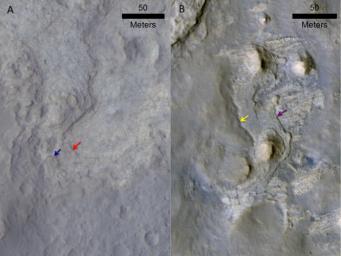Images of locations in Gale Crater taken from orbit around Mars reveal evidence of erosion in recent geological times and development of small scarps, or vertical surfaces. These two images come from the High Resolution Imaging Science Experiment (HiRISE) camera on NASA's Mars Reconnaissance Orbiter.
The image on the left shows the Yellowknife Bay area examined by NASA's Curiosity Mars rover during the rover's first 11 months on Mars. The red arrow points to the contact between the Sheepbed and Gillespie geological members. The blue arrow points to the contact between the Gillespie Lake member and overlying Glenelg member, which also forms a small scarp. These two geological contacts form scarps due to variations in rock hardness as eroded by the wind. The effect is to generate rock exposures that are relatively youthful in a geological timescale, on the order of 70 million years.
The image on the right shows the KMS_9 area, which Curiosity may investigate on the rover's route to Mount Sharp. The purple arrow points to the contact between the lowermost striated unit and the middle bedded unit. The yellow arrow marks the contact between the middle bedded unit and the upper smooth hummocky material. It is possible that the rocks adjacent to these scarps have also been only recently exhumed and exposed due to wind erosion.
The left image is a portion of HiRISE observation ESP_028335_1755, taken on Aug. 12, 2012. Other image products from this observation are available at http://www.uahirise.org/ESP_028335_1755. The right image was taken on Aug. 9, 2010, and other products from the same observation are available at http://www.uahirise.org/ESP_018920_175.
HiRISE is one of six instruments on NASA's Mars Reconnaissance Orbiter. The University of Arizona, Tucson, operates the orbiter's HiRISE camera, which was built by Ball Aerospace & Technologies Corp., Boulder, Colo. NASA's Jet Propulsion Laboratory, a division of the California Institute of Technology in Pasadena, manages the Mars Reconnaissance Orbiter Project for the NASA Science Mission Directorate, Washington.

 Planetary Data System
Planetary Data System












